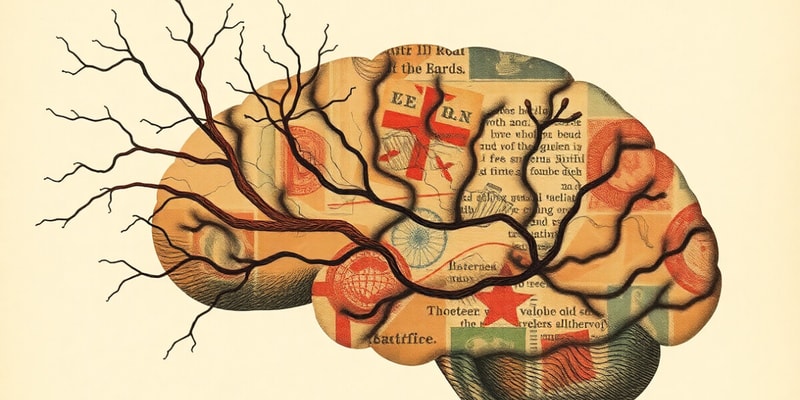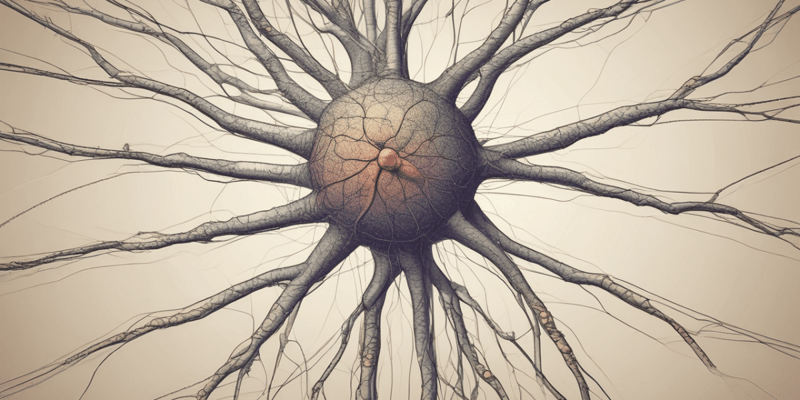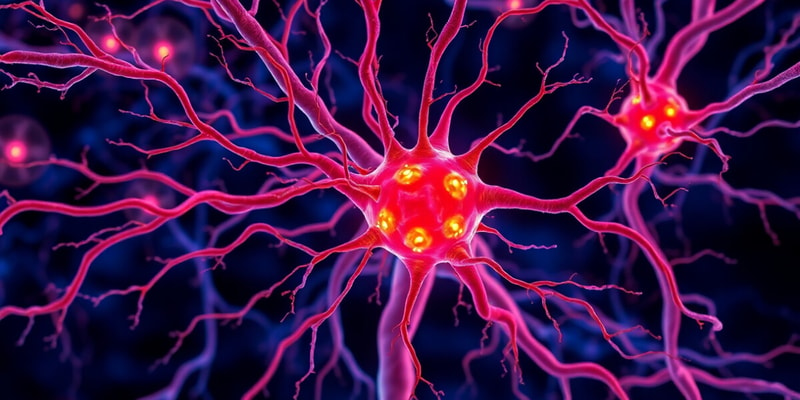Podcast
Questions and Answers
Which of the following correctly describes the role of neuroglia in the nervous system?
Which of the following correctly describes the role of neuroglia in the nervous system?
What is the primary function of the afferent division of the peripheral nervous system?
What is the primary function of the afferent division of the peripheral nervous system?
Which division of the peripheral nervous system controls voluntary muscle contractions?
Which division of the peripheral nervous system controls voluntary muscle contractions?
Which statement accurately describes the central nervous system (CNS)?
Which statement accurately describes the central nervous system (CNS)?
Signup and view all the answers
What distinguishes the autonomic nervous system from the somatic nervous system?
What distinguishes the autonomic nervous system from the somatic nervous system?
Signup and view all the answers
What type of response is characterized as a reflex?
What type of response is characterized as a reflex?
Signup and view all the answers
Which of the following represents the enteric nervous system?
Which of the following represents the enteric nervous system?
Signup and view all the answers
What is the primary function of effectors within the nervous system?
What is the primary function of effectors within the nervous system?
Signup and view all the answers
Which cranial meningeal layer is the most superficial and tough?
Which cranial meningeal layer is the most superficial and tough?
Signup and view all the answers
What function does the cerebrospinal fluid (CSF) NOT perform?
What function does the cerebrospinal fluid (CSF) NOT perform?
Signup and view all the answers
Which dural fold separates the cerebrum from the cerebellum?
Which dural fold separates the cerebrum from the cerebellum?
Signup and view all the answers
What is the role of the choroid plexus in the CNS?
What is the role of the choroid plexus in the CNS?
Signup and view all the answers
Which of the following spaces is found between the dura mater and the arachnoid mater?
Which of the following spaces is found between the dura mater and the arachnoid mater?
Signup and view all the answers
The superior sagittal sinus is located in which dural fold?
The superior sagittal sinus is located in which dural fold?
Signup and view all the answers
Which meningeal layer is directly attached to the surface of the brain?
Which meningeal layer is directly attached to the surface of the brain?
Signup and view all the answers
What is the primary function of the autonomic nervous system (ANS)?
What is the primary function of the autonomic nervous system (ANS)?
Signup and view all the answers
Which division of the ANS is responsible for 'rest and digest' activities?
Which division of the ANS is responsible for 'rest and digest' activities?
Signup and view all the answers
Which of the following statements is true regarding typical CNS neurons?
Which of the following statements is true regarding typical CNS neurons?
Signup and view all the answers
What structure attaches the initial segment of an axon to the cell body?
What structure attaches the initial segment of an axon to the cell body?
Signup and view all the answers
Which part of a neuron is primarily responsible for receiving signals from other neurons?
Which part of a neuron is primarily responsible for receiving signals from other neurons?
Signup and view all the answers
What is the role of Nissl bodies in a neuron?
What is the role of Nissl bodies in a neuron?
Signup and view all the answers
The extensive network of neurons in the walls of the digestive tract is referred to as what?
The extensive network of neurons in the walls of the digestive tract is referred to as what?
Signup and view all the answers
Which function is most characteristic of the sympathetic division of the ANS?
Which function is most characteristic of the sympathetic division of the ANS?
Signup and view all the answers
Which of the following structures is NOT a major part of a typical neuron?
Which of the following structures is NOT a major part of a typical neuron?
Signup and view all the answers
What type of muscle does the autonomic nervous system NOT directly regulate?
What type of muscle does the autonomic nervous system NOT directly regulate?
Signup and view all the answers
Which part of the brain is responsible for processing sight and sound?
Which part of the brain is responsible for processing sight and sound?
Signup and view all the answers
What structure connects the hypothalamus to the pituitary gland?
What structure connects the hypothalamus to the pituitary gland?
Signup and view all the answers
Which region of the brain primarily controls higher mental functions such as memory and intellect?
Which region of the brain primarily controls higher mental functions such as memory and intellect?
Signup and view all the answers
What is the function of the pons in the brainstem?
What is the function of the pons in the brainstem?
Signup and view all the answers
How many ventricles are found within the brain?
How many ventricles are found within the brain?
Signup and view all the answers
What primarily distinguishes the cerebral cortex from other brain structures?
What primarily distinguishes the cerebral cortex from other brain structures?
Signup and view all the answers
What regulates autonomic functions such as blood pressure and digestion?
What regulates autonomic functions such as blood pressure and digestion?
Signup and view all the answers
Which part of the brain is known for coordinating repetitive body movements?
Which part of the brain is known for coordinating repetitive body movements?
Signup and view all the answers
The thalamus plays a crucial role in what aspect of brain function?
The thalamus plays a crucial role in what aspect of brain function?
Signup and view all the answers
What feature characterizes the sulci in the cerebral cortex?
What feature characterizes the sulci in the cerebral cortex?
Signup and view all the answers
Which type of neuron is characterized by having processes that look similar and is typically found in the brain and special sense organs?
Which type of neuron is characterized by having processes that look similar and is typically found in the brain and special sense organs?
Signup and view all the answers
Which statement accurately describes unipolar neurons?
Which statement accurately describes unipolar neurons?
Signup and view all the answers
What differentiates motor (efferent) neurons from sensory (afferent) neurons?
What differentiates motor (efferent) neurons from sensory (afferent) neurons?
Signup and view all the answers
Which type of sensory neuron is responsible for monitoring the external environment?
Which type of sensory neuron is responsible for monitoring the external environment?
Signup and view all the answers
What purpose do proprioceptors serve in the body's sensory system?
What purpose do proprioceptors serve in the body's sensory system?
Signup and view all the answers
How are interneurons primarily characterized in relation to other types of neurons?
How are interneurons primarily characterized in relation to other types of neurons?
Signup and view all the answers
Which group of neurons primarily innervates smooth and cardiac muscle as well as glands?
Which group of neurons primarily innervates smooth and cardiac muscle as well as glands?
Signup and view all the answers
What is a key feature of bipolar neurons?
What is a key feature of bipolar neurons?
Signup and view all the answers
Which of the following statements is true regarding sensory receptors?
Which of the following statements is true regarding sensory receptors?
Signup and view all the answers
What feature distinguishes multipolar neurons from other types?
What feature distinguishes multipolar neurons from other types?
Signup and view all the answers
Study Notes
Nervous Tissue
- The nervous system includes the brain, spinal cord, and receptors in sense organs.
- Nervous tissue is composed of neurons and neuroglia (glial cells).
- Neurons are the functional units, specialized for intercellular communication.
- Neuroglia support neurons, also known as glial cells.
Anatomical and Functional Divisions
- The nervous system is divided into the central nervous system (CNS), peripheral nervous system (PNS), and the enteric nervous system (ENS).
- The CNS includes the brain and spinal cord.
- The CNS processes and coordinates sensory data and motor commands.
- The PNS is the nervous tissue outside the CNS and the ENS, conveying sensory info to and motor commands from the CNS.
- The PNS has two main divisions: afferent (sensory) and efferent (motor).
- The CNS does not have functional divisions like the PNS.
Neurons: Functional Characteristics and Structure
-
Neurons are generally long-lived and have a high metabolic rate.
-
Neurons have an excitable plasma membrane.
-
Typical CNS neurons do not divide after injury or infection.
-
A neuron has a cell body, dendrites, an axon, and telodendria.
-
The cell body (soma) contains the nucleus and perikaryon (cytoplasm).
-
Dendrites receive signals.
-
Axons transmit signals.
-
Axolemma is the axon's cytoplasm.
-
Initial segment is the base of the axon.
-
Axon hillock attaches initial segment to the cell body.
-
Collaterals are branches of the axon.
-
Axon terminals (synaptic terminals) are the tips of telodendria.
Classification of Neurons
- Neurons are classified structurally based on the relationship of their dendrites, cell body, and axon.
- Types include anaxonic, bipolar, unipolar, and multipolar neurons.
- Unipolar neurons are primarily sensory neurons of the PNS.
- Multipolar neurons are the most common type and include all motor neurons in the CNS.
Functional Classification of Neurons
- Sensory neurons transmit information from sensory receptors to the CNS.
- Motor neurons carry instructions from the CNS to peripheral effectors.
- Interneurons connect sensory and motor neurons.
- There are three different kinds of sensory receptors (interoreceptors, exteroreceptors, and proprioceptors).
CNS Neuroglia
- Neuroglia are support cells in the CNS.
- Types include astrocytes, ependymal cells, oligodendrocytes, and microglia.
- Astrocytes support and form the blood-brain barrier.
- Ependymal cells produce cerebrospinal fluid (CSF).
- Oligodendrocytes form myelin sheaths.
- Microglia are phagocytes.
PNS Neuroglia
- Satellite cells and Schwann cells are support cells in the PNS.
- Satellite cells surround neuron cell bodies in ganglia.
- Schwann cells form myelin sheaths in axons of the PNS.
- Neurolemma is the outer layer of the schwann cell, which aids in axon regeneration.
Membrane Potential
- Membrane potential is a key concept for neurons.
- It's important due to ion movements within plasma membranes.
- Resting membrane potential is the membrane potential of a resting cell.
- Graded potentials are temporary localized changes in resting potential.
- Action potential is a propagating electrical impulse along an axon surface.
Membrane and Action Potential Processes
- The movement of ions across the membrane is driven by electrochemical gradients.
- Current is the movement of charges eliminating a potential difference.
- Resistance is how much the membrane restricts ion movement.
Active Ion Channels and Processes
- Active (gated) ion channels include chemically (ligand) gated, voltage-gated and mechanically gated ion channels.
- A chemically gated channel opens when a specific chemical binds to it; voltage-gated channels open in response to a change in the membrane potential.
- Mechanically-gated ion channels open in response to distortion of the membrane.
- There are three possible states for a voltage-gated channel: closed, open and closed but capable of opening (inactivated).
Graded Potentials
- Graded potentials result from changes in membrane potential.
- Graded potentials produce either depolarization or hyperpolarization.
- The change in potential in graded potentials are proportional to the stimulus.
- Graded potentials are temporary and only affect a localized area of membrane.
Action Potentials
- Action potentials are all-or-none electrical impulses used for long-distance communication.
- They begin at the initial segment of the axon.
- They are propagated, and do not diminish.
- Threshold is the membrane potential at which an action potential is triggered.
- All action potentials are the same in strength and size.
Propagation
- Action potential propagation occurs in two ways: continuous propagation and saltatory propagation.
- Continuous propagation occurs in unmyelinated axons, while saltatory propagation occurs in myelinated axons.
- Saltatory propagation is faster than continuous propagation.
Synaptic Transmission
- Synapses are specialized sites where neurons communicate with other cells.
- A synapse includes a presynaptic neuron that sends the message, and a postsynaptic neuron.
- A synapse has a synaptic cleft in between the two neurons. There are two basic types: electrical and chemical synapses .
Chemical Synapses
- Most common type of synapse between neurons and other cells.
- Chemical synapses use neurotransmitters as messengers.
- Neurotransmitters bind to receptors on the postsynaptic membrane.
- There are different kinds of neurotransmitters: excitatory, inhibitory, and neuromodulators.
- Synaptic delay, is the time elapsed between the arrival of a signal and the effect on the postsynaptic membrane.
Studying That Suits You
Use AI to generate personalized quizzes and flashcards to suit your learning preferences.
Related Documents
Description
Explore the components and divisions of the nervous system, including neurons and neuroglia. This quiz covers the structure and functional roles of the central, peripheral, and enteric nervous systems. Test your knowledge on how these systems work together for communication and coordination.



